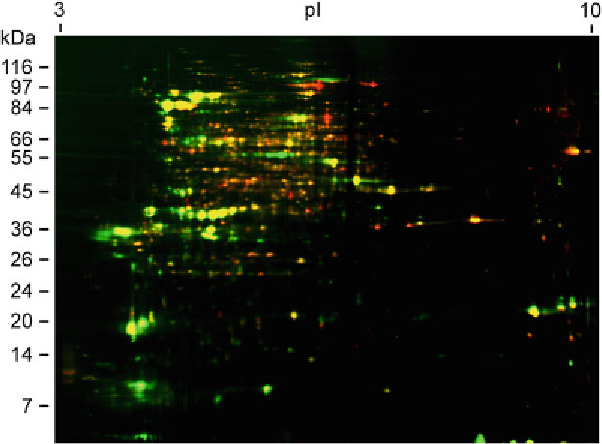Biology Reference
In-Depth Information
Fig. 2
Protein dynamics during
G. max
(L.) Merr. seed development. Total protein fractions were isolated from
S2 (27-42 mg) and S4 (115-150 mg) soybean seeds, and compared by Difference InGel Electrophoresis
(DIGE). Proteins from S2 seeds were labeled with Cye 3, while proteins from S4 seeds were labeled with Cye 5.
The combined proteins were separated in the fi rst direction by isoelectric focusing using an immobilized 3-10
pH gradient, and by SDS-PAGE in the second dimension using a 10-18 % acrylamide gradient gel. Proteins
that are equally abundant in the two stages appear as
yellow dots
, while proteins more abundant in the S4
seeds appear
green
and those more abundant in the S2 seeds appear
red
seed age expressed as a chronological age (Days After Flowering,
DAF, or Days After Anthesis, DAA). This is unfortunate because
there is essentially no correlation between the chronological ages
of a seed from a growth-chamber grown plant in January and a
fi eld-grown plant in June. Instead of chronological age, seed biolo-
gists have developed various staging platforms that are indicative of
physiological age. This staging is typically based upon easily quanti-
fi able characteristics such as fresh weight, size (length×width),
color, and a series of morphological and anatomical features [
24
-
26
]. These staging systems can be very robust, and are far more
reliable than chronological age. Especially during the period of cel-
lular specialization, there are substantial differences in the protein
profi les of seeds at different physiological ages. The results of two-
dimensional DIGE analysis of developing soybean cotyledons high-
light both protein complexity and dynamics as seed development
proceeds (Fig.
2
). Similar dynamic complexity has also been reported
for developing castor [
21
] and rape (
Brassica napus
) [
26
] seeds.
Mature seeds can be quiescent or dormant. Quiescent seeds
are “dry” (5-15 % moisture) and metabolically inert. They are
capable of shifting to metabolic activity, requiring only hydration

